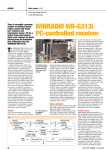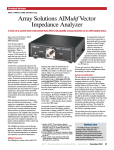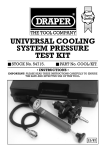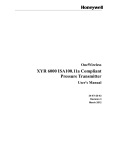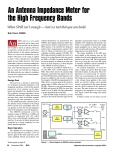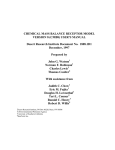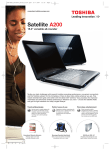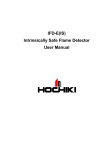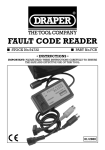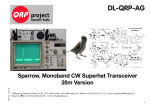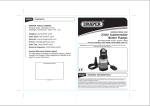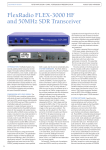Download 12_13_14_radcom_jul0..
Transcript
12_13_14_radcom_jul07 13/6/07 14:56 Page 12 PRODUCT REVIEW CHRIS LOREK PO BOX 400, EASTLEIGH, HAMPSHIRE SO53 4ZF G4HCL EMAIL [email protected] AIM4170 Antenna Analyser Chris Lorek falls in love with this versatile PC-based instrument 12 Photo 1:The AIM4120 is a compact size Photo 2: Rear panel connections for DC power and RS-232 BACKGROUND. When I first started the hobby many years ago, I realised that an essential accessory to my shack was most certainly an SWR meter. This allowed me to keep an eye open for antenna problems as well as making sure my transmitter was given a good match to my antenna system. I still have that same meter now, tens of years later, and I still wouldn’t be without one. When I started a new job around 18 years ago I was introduced to using a Hewlett Packard RF Network Analyser, costing over £30,000, to perform antenna systems tests with. How I wish I’d have been able to use one earlier, especially during the time I worked hard to invent an electronic automatic antenna tuning unit. What had taken me a significant time for a simple impedance measurement would have taken less than a minute, so that I could really see what my antenna system was doing. But haven’t times moved on since then! As soon as I saw the AIM4120, I was immediately interested and I was pleased to be able to test one. kHz and 170 MHz. The accompanying PC control program calculates the actual displayed parameters such as an SWR graph, Smith Chart etc, and plots the results onto screen in ‘real time’ either as a single sweep or as a continuous measurement. Results of each sweep can of course be saved for subsequent analysis and to compare results. Although most amateurs will use a nominal 50 ohms antenna and coax impedance, the analyser can make measurements up to 10 kilohms with ‘true’ measurements of inductive and capacitive reactance. You could thus use it to measure the resistance and reactance of discrete components such as capacitors and coils for homebrew projects. As well as measuring these parameters at the physical point of the coax connector on the unit, a quick ‘calibration’ procedure can be performed with an open, short, and known resistive load, each at the end of any length of coax cable you’re using; these terminations are usefully provided with the analyser. With this, the coax is ‘normalised’ out and your measurements are that of the actual antenna system itself which is connected to the end of your coax. It can also detect whether you have a cable fault, such as an open or short some way along the length, as well as the actual cable loss etc. If you can’t get to the end of your coax easily, for example if it’s up a fixed mast or FEATURES. The AIM4170 antenna analyzer uses a small box containing the actual hardware, together with your shack or laptop PC for the ‘user interface’. The system is designed to measure complex impedance (ie both magnitude and phase) across any selected range between 100 tower, you can use the analyser to detect the electrical length of the coax from a phase measurement and use this instead, or indeed you can enter the coax length plus the velocity factor from manufacturer’s figures. In a nutshell, the analyser can measure and display in a linear/log graph or Smith Chart format: •SWR referenced to any impedance •Resistance and reactance at the cable input •Resistance and reactance at the antenna terminals •Resistance and reactance of discrete components •Return loss •Reflection coefficient •Cable length •Cable impedance •Cable loss •Distance to coax fault (open or short) •Component and quartz crystal parameters CIRCUITRY. Inside the unit, two digital synthesisers are used to generate the required test frequencies, along with bandpass filters to reduce the effects of external signals such as strong local RF signals from other transmitters which could corrupt your readings. A 12 bit analogue to digital converter is used rather than a simple diode detector, which gives far better linearity for more accurate measurements. Most SWR meters just use diodes. The internal RF generator can also be used as a local signal source, for example to check your receiver. SIZE. The unit itself is compact, measuring 127 W x 40 H x 108mm D. A handy ‘quick start’ guide is provided along with a CD containing the complete user manual in pdf format, the operating program, and other files such as configuration data and a help file, Also supplied is a ready-made RS-232 lead and a set of small calibration loads terminated in suitable BNC connectors. A BNC to SO-239 coax adapter is also provided so that you can connect a coax terminated in a PL-259 plug to the unit. POWER. The AIM4170 is powered from a 6-15V DC supply. A rear panel socket is provided for an external supply. There’s RadCom ♦ July 2007 12_13_14_radcom_jul07 13/6/07 14:56 also enough room inside the unit if you want to fit a 9V PP3 sized battery. A diode circuit is fitted within the circuitry so that an external supply and any internal battery won’t interfere with each other. The unit consumes around 50mA when switched on and around 250mA when a measurement is in progress. With the unit switched off, the current drawn is less than a microamp, and an ‘auto power off’ mode is available which can switch the unit off after 10 minutes of no commands being received from a PC. IN USE. Units sold in the US come with a plug-in 110V AC to 12V DC wall supply, but many amateurs will already have a suitable 12V DC source in their shack. Having plugged in a suitable lead and connected up, I then just copied the files from the CD onto a sub-directory on my PC and clicked on the AIM_562.exe program, Page 13 which set the system running. Then, with the RS-232 lead connected between the analyser and my PC, I just selected the correct comm port for my PC and I was in business. What could be simpler? If your PC doesn’t have any RS-232 ports then you’ll need to use an in-line RS-232 to USB adapter. I’m told that current releases of the program, version 564 onwards, have a “Find comm port” function to automatically scan for the correct port which makes things even easier. The system can itself be run from just the CD if you wish, eg for use round at a friend’s shack. It’s only when in ‘calibrate’ mode that files need to be written to the program directory (or even just a floppy disk if your PC accepts one). The latest software version (including user manual), which can be used in demo mode without the Photo 3: Inside the unit, a well-built layout with room for an internal battery 7 0 0 2 C F H RS GB ! t n ve 2007 E er b A o IOT th Oct 14 & h F 2t r Hshire e i em rd r dfo P e B ds re, rl s Cent o W ke a e L h T ton s o b Wy E U N E V NEW & ME RS O C E L WE DINN5.00 2 X D M£ FRO OK BONLINE O DAY TO 1 res ectu ures L n ct tures io l Le edit c z DXp nationa ical Le 50MH r n e h t z c H In e 36k or T CH. Maj ands 1 U M B E .. H, All M C LOW MUTO CO CES I D R P R NGS AN RE 9 737 MO FO OKI RE 04 9 70 BOEFO UG . 08 L E T B th A ION fc h MAT / 14 R O g E r NF IN o b. g s .r ww : L EI OR OK ON M R O B O F TO OR w sors pon or S Maj 12_13_14_radcom_jul07 13/6/07 14:56 Page 14 PRODUCT REVIEW Figure 1: 2m antenna array VSWR plot FIGURE 1 Fout DDS AD9859 0.1–170MHz Low Pass Filter ANT Mixer NE612 XTAL OSC 20MHz AMP and stop frequency, or individual pre-stored amateur bands, to measure across. 1KHz Following a measurement I could store Low Pass DDS Filter AD9859 scan files as well as simply print out the AMP ANALOG Mixer scan onto a connected printer. NE612 CPU MSP430 Beside using my mouse to select DIGITAL operational modes, several one-touch ‘hot key’ functions were available, for example to scan, rescan, enter new limits and so on. RS232 PC One handy function I used the analyser for during the review period was to make up a © RADCOM number of quarter-wave coax ‘stubs’. These I’d use in line with my VHF system term use, I stored the antenna coax to notch out pager breakthrough on receive parameters for each system to disc so that as well as reducing the level of 6m I could ‘keep an eye’ on what the ravages transmitter 2nd harmonics. Living in a of weather could bring; the software could rather RF congested area as well as a usefully superimpose either repeated planned ‘housing estate’ village with over scans, or a scan and a stored scan file, for 100 amateurs within a mile radius, I me to compare. quickly found myself popular with several For each scan, various graph colours are neighbouring radio colleagues in offering a used for traces, which correspond to those measurement service for their needs as along the vertical axis: well as general measurements! I was impressed with the AIM4170, and •Red – SWR checking the performance against a •Green – Magnitude of the Impedance •Orange – Resistive Part of the Impedance hardware-based laboratory calibrated RF network analyser showed no discernible •Yellow – Reactive Part of the Impedance difference in measurements across the •Violet – Phase Angle of the Impedance operational range. The only difference was •Blue – Return Loss that the AIM4170 was rather more As I moved my PC mouse along the Figure 2: 80m / 40m trapped dipole Smith Chart Plot graph scale, the actual parameter values of portable, especially when operated from an internal battery and linked to a selfeach of these were shown on the display, powered laptop. Also, the other (rather eg the exact SWR figure etc, rather than hardware, can be downloaded from the more expensive) analyser when coupled to having to try to visually read this from the manufacturer’s web site at an external HF antenna system showed graph display. The data can even be www.w5big.com/prog_update.htm. plenty of ‘blips’ from off-air signals, usually sounded out in Morse for visually-impaired I started with a simple check of my above around 6MHz, whereas the filtering amateurs. I could select either an entire existing antenna systems for VSWR, in the AIM4170 in the same measurement spectrum such as 1.8-30MHz, any start although the analyser also showed me situation completely got rid of where the actual resonance these and thus gave a more occurred, which was often accurate measurement. I was different to the lowest SWR! very happy indeed in using Using this, I managed to ‘fine the AIM4170, so much so tune’ some of my antennas, that I purchased it at full price including my multi-band three following the review for the element HF yagi of which I had use of myself and my originally tuned the traps, colleagues at my place of several years ago, simply for work for portable and off-site lowest SWR on each band. use. Resonating this correctly should The AIM427 is currently of course have improved the priced at £279 inc VAT and is front to back ratio as well as the distributed in the UK and Eire forward gain and side lobe by Vine Antennas Ltd., Tel performance, a worthwhile time 01691 831111, who our spent! Likewise on 2m and 6m, where I found my antennas were Figure 3: 80m / 40m trapped dipole VSWR plot, the coax length effects can easily be thanks go to for the loan of the analyzer for review. each a little ‘out’. For longer seen Fout + 1KHz 14 RadCom ♦ July 2007




